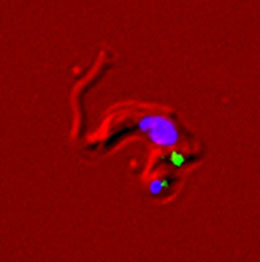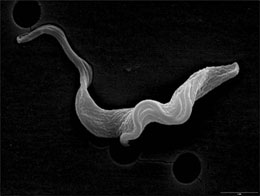How Scottish scientists could help ‘neglected diseases’ in poor nations

The new medication will be used to treat diseases caused by parasites such as T.brucei (pictured).
Millions of lives across the world could be saved in future thanks to a discovery by experts at the Universities of St Andrews and Edinburgh. The research opens the door to a potentially revolutionary way of treating Sleeping Sickness and childhood brain cancer.
Existing treatments for these illnesses, known as 5-nitrofurans, can for some patients have severe side effects which often force patients to give up the medication.
Now, a joint team of scientists at St Andrews and Edinburgh has discovered the cause of these crippling side-effects, opening a path to creating a new treatment within a few years.
The research team has proposed an alternative drug combination which could be more effective with fewer side-effects.
Dr Nick Westwood, Reader in Chemistry and Chemical Biology at the University of St Andrews, said: “We have listened to the message sent by patients. The class of drugs that includes Nifurtimox is effective but many people struggle to complete the course of treatment due to the serious side effects.
“Our collaborative work with Dr Elizabeth Patton at the University of Edinburgh leads to a potential solution to this problem which we believe should be trialed in the clinic as soon as possible.”
Dr Liz Patton, Group leader in the Institute of Genetics and Molecular Medicine at the University of Edinburgh, said: “This is a big step forward for understanding how 5-nitrofuran drugs work, and gives us a realistic window of opportunity to help improve available treatments.
“Our next step is to test the effects of this combination treatment in human cells and tissues.”

Nifurtimox is currently in clinical trials for childhood cancers, neuroblastoma and medulloblastoma. It is also used mostly to treat Chagas disease and has recently been introduced as a treatment for Sleeping Sickness in combination with eflornithine.
The team took a radically different approach to treating diseases in the five-year study. Rather than creating a new drug from scratch, they have developed a detailed understanding of how the side-effects of a known drug arise. This has allowed them to open the door to a potentially revolutionary way of improving the treatment of diverse diseases.
Dr Terry Smith, Reader in the School of Biology at the University of St Andrews, who contributed to the project, said: “This new therapy combination should allow more patients to continue with the treatments which could save their lives. This combination will be more effective meaning patients will have an improved prognosis and treatments will be more cost-effective.”
Parasitic diseases, African Sleeping Sickness and Chagas Disease in South America, are regarded as “neglected diseases” as current treatments have changed little in 60 years and are often too expensive, hard to administer and can be highly toxic for victims. On occasion patients can be killed by the medication before the disease.
In Sub-Saharan Africa there are 70 million people at risk of Sleeping Sickness and current World Health Organisation (WHO) figures show that at least 30,000 die each year.
In South America, there are more than 100 million people at risk of Chagas disease with between 1-2 million people infected at any one moment.
PhD student Linna Zhou, one of the lead authors, said: “This has been a really exciting collaboration to be involved in and we hope our research will have an enormous human and economic effect on the regions which are blighted by these terrible illnesses.”
The research is published online.
ENDS
Note to Editors
Dr Nick Westwood is available on 01334 463816.
Issued by the Press Office, University of St Andrews
Contact Fiona MacLeod on 01334 462108/ 0771 414 0559.
Ref: (nitrofurans 30/07/12)
View the University’s latest news at http://www.st-andrews.ac.uk/news/
Category Research